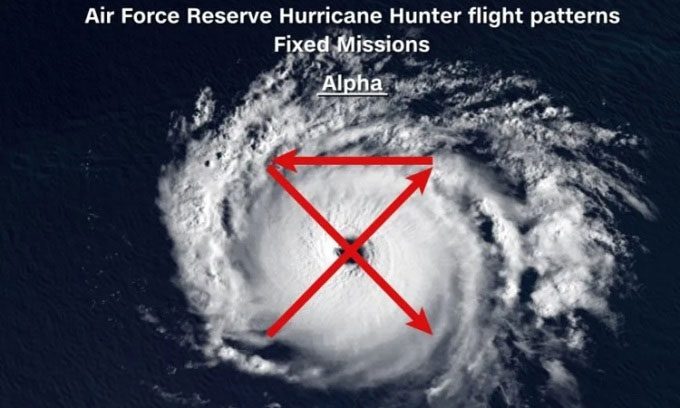The flight patterns of storm chasers may resemble boxes and stars, but they serve specific purposes for each storm.
Storm chasers do not fly far from the storm like commercial airplanes typically do. Instead, they fly straight into the storm, albeit not in a random manner, according to CNN. There are two independent groups of storm chasers: the National Oceanic and Atmospheric Administration (NOAA) and the United States Air Force Reserve (USAF). Both organizations conduct missions into tropical storms to gather invaluable data for forecasters at the National Hurricane Center (NHC). For storm chasers, there are two main types of missions: fixed and reconnaissance.

Alpha flight patterns are very common among storm chasers. (Photo: CNN).
Fixed Missions
Fixed missions are designed to expose the system to characteristics of tropical cyclones such as tropical depressions, tropical storms, and hurricanes. The main goal is to mark the center of the circulation, monitor wind speeds and pressure changes, along with many other factors that satellites in space cannot measure in detail. For fixed missions, Alpha is the most popular flight pattern used to collect data in tropical storms.
“The Alpha flight pattern is our standard flight for fixed missions, so people are most familiar with it,” said Major Jeremy DeHart, a meteorologist and aerial reconnaissance weather officer with the 54th Weather Reconnaissance Squadron. This flight pattern consists of two legs flown diagonally. Once completed, the flight path forms the Greek letter Alpha, including the intersection line.
The geographical directions are standard points on the compass, including east, west, south, and north. Diagonal directions refer to northeast, southeast, northwest, and southwest. The stronger the storm, the easier it is to fly into. “From my perspective as a meteorologist on the aircraft, the Alpha pattern is the easiest to fly. Since we often fly this pattern in strong storms, there is not much uncertainty about the eye of the storm,” DeHart shared. “Of course, the flight can be quite bumpy, but at the end of the day, we are just flying through the eye of the storm to collect data and send it to the NHC.”
Reconnaissance Missions
The main purpose of reconnaissance missions is to determine whether a system meets the definition of a tropical cyclone, which includes unnamed storms or any true tropical structural characteristics. For reconnaissance missions, the NHC typically sends estimated coordinates of where the center of the circulation is believed to be. This is the starting point that missions often target. However, reconnaissance missions are somewhat flexible regarding flight patterns due to the inherent uncertainties of the storms. “We never know exactly where we are going, but we always have to think one or two steps ahead,” DeHart shared.

X, Delta, and box flight patterns. (Photo: NOAA).
Storm chasers from the USAF have many flight patterns to choose from for reconnaissance missions, such as X, Delta, and box patterns. According to DeHart, these missions are ideal for weak and uncertain storms. While the X pattern may resemble the Alpha pattern, the aircraft flies at a much lower altitude, around 15 – 30 meters. Once the system becomes a tropical storm or hurricane, storm chasers start flying at higher altitudes from 1,524 to 3,048 meters, depending on the storm’s strength.
The flight range for Delta and box patterns is typically at 1,524 meters or lower. “The Delta and box patterns are similar in that we will fly around the edge of the storm’s eye, trying to observe the winds at all four corners of the storm, revealing whether a closed circulation exists. If we find a closed circulation, we can locate the eye of the storm.”
NOAA’s Research Focus
The NOAA storm chaser team also conducts fixed and reconnaissance missions, but they often have a research orientation. They fly in various specialized patterns, using multiple types of aircraft, depending on the assigned mission. Additionally, they conduct a third type of mission known as general missions. For fixed missions, NOAA typically flies in a figure-four, reverse figure-four, or butterfly pattern. According to Jonathan Shannon, a public affairs specialist at NOAA’s Aircraft Operations Center, the figure-four and butterfly patterns are often used to locate the center of the storm’s circulation.
For reconnaissance missions, the aircraft fly in a lawnmower pattern or square spiral if the area being checked has tropical characteristics. Paul Flaherty, the science director at NOAA’s Aircraft Operations Center, shared that flying in the lawnmower pattern helps them map a wide area. After fully identifying the circulation, they will switch to a figure-four flight based on the newly discovered eye location. The square spiral flight is a survey mission aimed at providing observations of structure and characteristics, including information about the eye of the cyclone if it exists.
Additionally, a third flight pattern is often used to sample the surrounding atmosphere, helping forecasters determine the storm’s movement. Star pattern 1 focuses on scanning the outer edge of the storm system, while star pattern 2 helps determine the circumference near the center of the circulation.
Regardless of which agency the storm chaser belongs to, their flight missions form the foundation of the National Hurricane Center, which is responsible for essential information regarding the storm. The NHC receives data and uses it to guide and advise the public about the strength of the storm.


















































